I’m passionate about volleyball, and mastering the setting technique is key. It connects the hitters to the court. At first, my setting was all over the place. But with practice and the right drills, I got better.
Setting is vital in volleyball. Setters touch the ball the most. Good touches and technique are essential for clean sets. Common mistakes include bad footwork and wrong hand positioning.
Key Takeaways
- Proper setting technique is essential for running an effective offense in volleyball
- Common setting issues include poor footwork, low hand positioning, and improper follow-through
- Targeted drills can help improve accuracy, consistency, and ball control for setters
- Focusing on fundamental skills like footwork and hand positioning is key to becoming a better setter
- Consistent practice and repetition are vital for developing muscle memory and game-ready setting abilities
Understanding the Role of a Setter in Volleyball
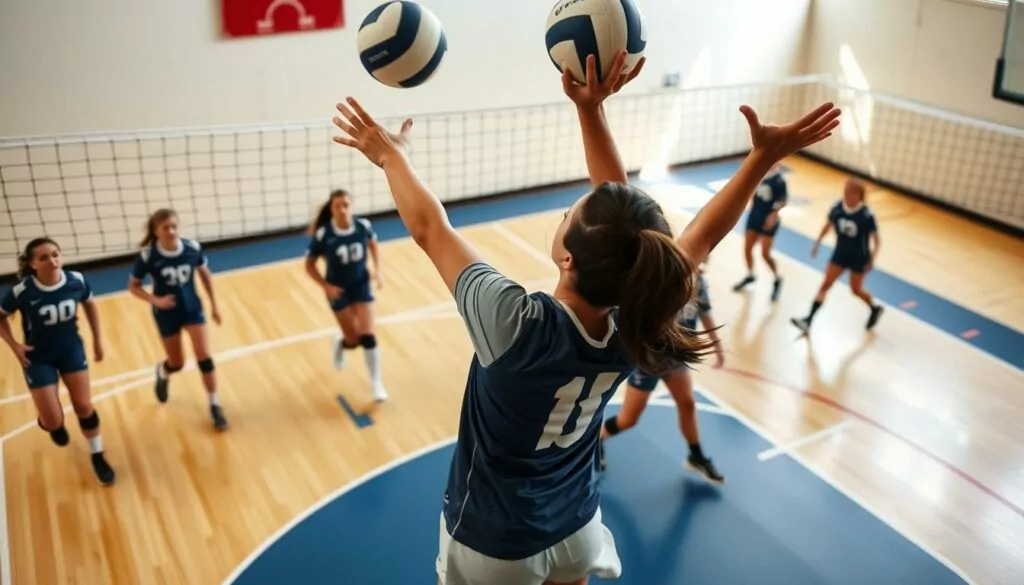
In volleyball, the setter is key to the team’s offense. They are the second touch player, guiding the game flow. Knowing what a great setter does is vital for any volleyball player or fan.
What Makes a Great Setter?
A great setter excels in technical skills. They use volleyball setting techniques like correct hand placement and footwork. They also need to read the game quickly and make smart decisions.
The Importance of Communication
Communication is central to a setter’s job. They must talk well with teammates to plan plays and adjust strategies. Good communication helps the team work together smoothly.
Key Skills Every Setter Should Master
- Proper setting fundamentals, including hand positioning and footwork
- Ability to deliver accurate, consistent sets to various hitters
- Adaptability to different game situations and offensive schemes
- Visual awareness to scan the court and anticipate the play
- Decision-making skills to choose the optimal set based on the game situation
- Leadership qualities to direct the team’s offense and inspire their teammates
The setter’s role in volleyball is complex. It requires technical skill, strategic thinking, and good communication. By mastering these, setters can lead their team to success, helping their hitters and winning games.
Basic Setting Techniques
Mastering the basic setting techniques is key for any volleyball player. It involves proper hand positioning, efficient footwork, and setting the ball perfectly. Let’s explore these essential skills.
Hand Positioning Fundamentals
Getting your hands in the right position is vital for setting the ball accurately. Form a small triangle with your hands above your forehead. Keep your fingers spread wide and thumbs together. This helps you cushion and guide the ball precisely.
Footwork Essentials
Footwork is the base of good setting. Step to the ball with your left foot, then your right, moving your weight through the ball. This balanced movement puts you in the best spot for a clean set.
Creating the Perfect Set
To set the ball perfectly, combine good hand positioning and footwork. Use a consistent catch and release motion. Cushion the ball with your hands and then guide it smoothly to your target. This ensures your teammates can spike or attack effectively.
By mastering these basic techniques, you’ll improve your setting skills. Remember, practice and focus on details are essential. They’ll help you become a more reliable setter.
Essential Setting Drills for Beginners
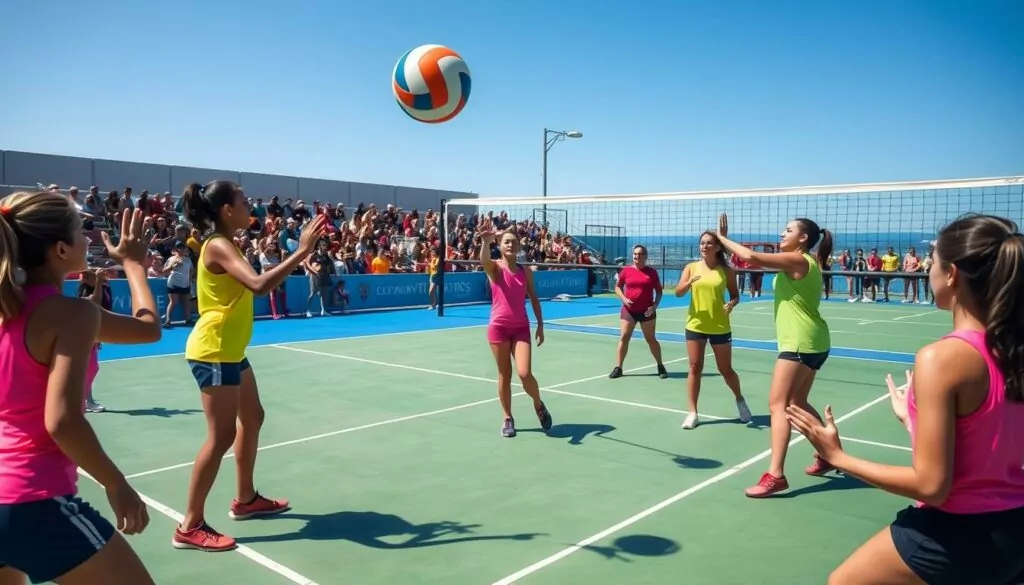
As a volleyball setter, controlling the ball and timing are key. They help you set the ball accurately to your teammates. There are beginner-friendly drills that can improve these skills. Let’s look at some important setting drills to boost your court performance.
Wall Sets for Consistency
The wall set is a basic drill for setters. It helps with ball control and consistency. Start near a wall and set the ball, increasing distance as you get better. Aim for a smooth release and consistent ball contact.
Partner Sets for Timing
Timing is critical for setters. Partner drills can improve this skill. Practice setting with a teammate, focusing on a steady rhythm and smooth transitions. Watch your partner’s moves and anticipate their needs for perfect sets.
Target Practice Drills
Accuracy is vital in setting. Target drills enhance your spatial awareness and precision. Set the ball to marked spots or cones on the court. As you get better, try setting from farther away or to different targets.
The “Lie down, set up” drill is great for hand positioning and release. Lie on the floor, set the ball straight up, and catch it as it falls. This drill helps you control and set the ball better.
These volleyball setting drills are perfect for beginners. You can do them at home or in various places. By practicing these drills, you’ll strengthen your setting skills and improve your game.
Intermediate Setting Drills to Improve Skills
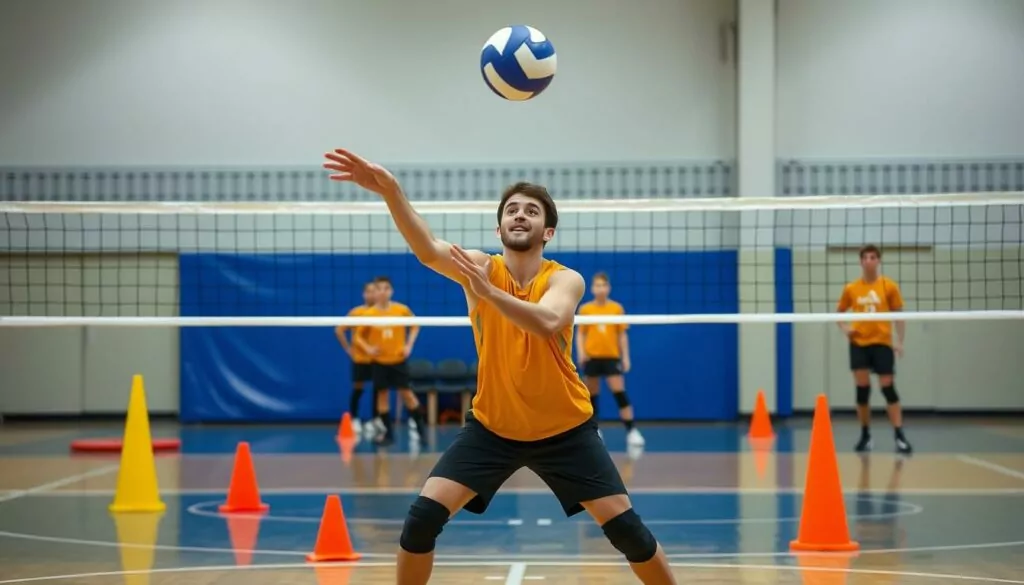
As a volleyball player, improving your setting skills is key to bettering your game. We’ll look at drills for intermediate players. These drills will boost your versatility, decision-making, and court awareness.
Setting with Movement
The “Set and Go” drill is great for setting, mental training, and conditioning. You set the ball and then sprint after it. This simulates a fast-paced volleyball game.
By adding movement to your setting, you’ll get better at footwork and decision-making. This makes you a more complete setter.
High Ball vs. Low Ball Setting
Learning to set both high and low balls is essential. Practice these sets to handle different game situations. High ball setting boosts your hitters’ power.
Low ball setting can surprise the defense. Working on both high and low ball setting makes you more versatile and unpredictable.
Setting from Different Angles
Being able to set from various angles shows you’re an elite setter. Try setting from the left, right, and back rows. This expands your setting skills.
By mastering setting from different angles, you become a dynamic playmaker. You can lead your team’s offense from any court position.
Remember, regular volleyball setting drills and setting practice are vital. Embrace these intermediate drills to become a top setter on the court.
Advanced Setting Drills for Elite Players
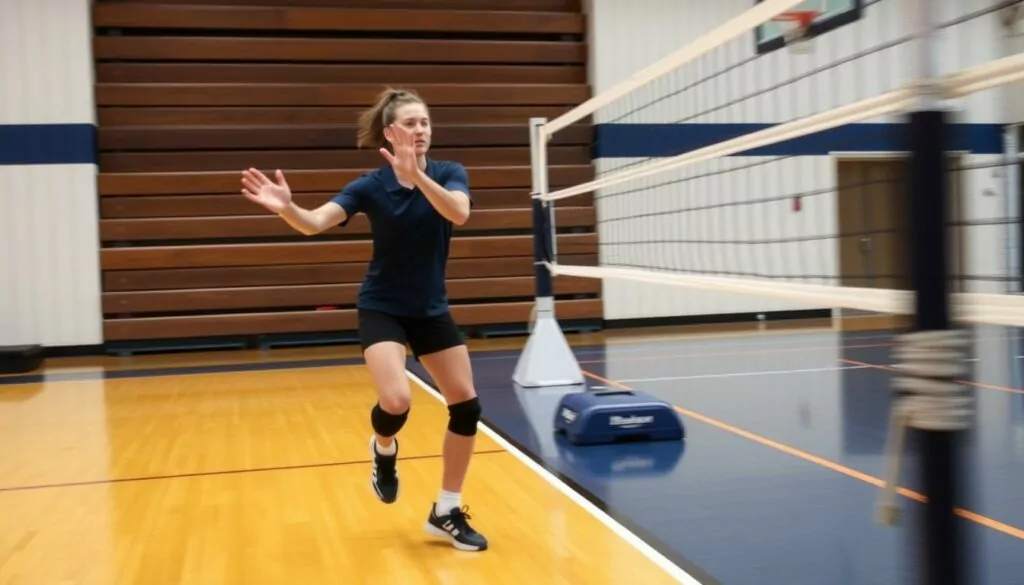
To be a top volleyball setter, you must go beyond the basics. You need to master back row setting and no-look sets for deception. These drills will make you a skilled player who can handle pressure well.
Back Row Setting
Back row setting is key for setters who want to cover more of the court. This drill prepares you for setting from the back row. It improves your footwork, body positioning, and ball placement.
Regular practice will boost your confidence and decision-making skills. This is vital for playing under pressure.
No-Look Sets for Deception
No-look sets add a trick to your setting. They confuse the opposing team and open up chances for your hitters. This skill requires great spatial awareness and ball control.
It’s a must-have for elite setters.
Setting Under Pressure
A top setter can handle the heat. Drills that mimic game scenarios, like setting with a defender closing in or setting with a short time window, are essential. They help you stay calm and make smart decisions.
These drills will take your setting to the next level.
For a detailed training program, check out the Triangle Setting Series and 4-Corner Setting drills by Chris P. Austin. They’ll push you to make fast decisions and control the ball perfectly.
Becoming an elite setter is a journey. By adding these drills to your routine, you’ll become more versatile, deceptive, and composed. This will help your team succeed at the highest levels.
Incorporating Defense into Setting Drills
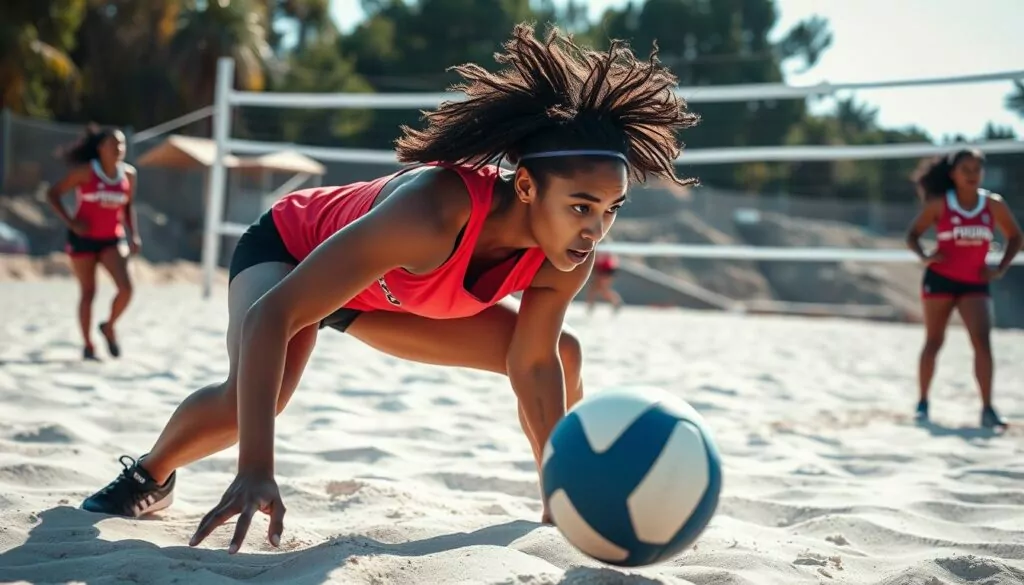
As a volleyball setter, mastering setting and defense is key. Adding defensive drills to your routine boosts your court awareness and reaction time. These skills are vital for a top-notch setter. Let’s dive into drills that mix defense and setting to improve your game.
Transitioning from Defense to Setting
Setters need to move fast from defense to setting. The “Up and Back Setting” drill is perfect for this. Start in a defensive stance, then shuffle and backpedal to set the ball. This drill sharpens your reflexes and footwork for quick transitions.
Setting After a Dig
Setters often set right after digging the ball. This drill boosts your reaction time and adaptability. Have a teammate dig the ball, then set it quickly. Focus on fast decision-making and accurate setting from different spots on the court.
| Drill | Description | Benefits |
|---|---|---|
| Up and Back Setting | Start in a defensive stance, shuffle laterally, then backpedal and set the ball. | Develops transitional footwork and reflexes from defense to setting. |
| Setting After a Dig | Set the ball immediately after a defensive dig by a teammate. | Improves reaction time and adaptability when setting from various positions. |
Adding these drills to your volleyball drills for setters and setter training will sharpen your skills. It also boosts your court presence and defense. Remember, the best setters can smoothly switch between offense and defense, making them key team players.
Drills for Setting Tempo
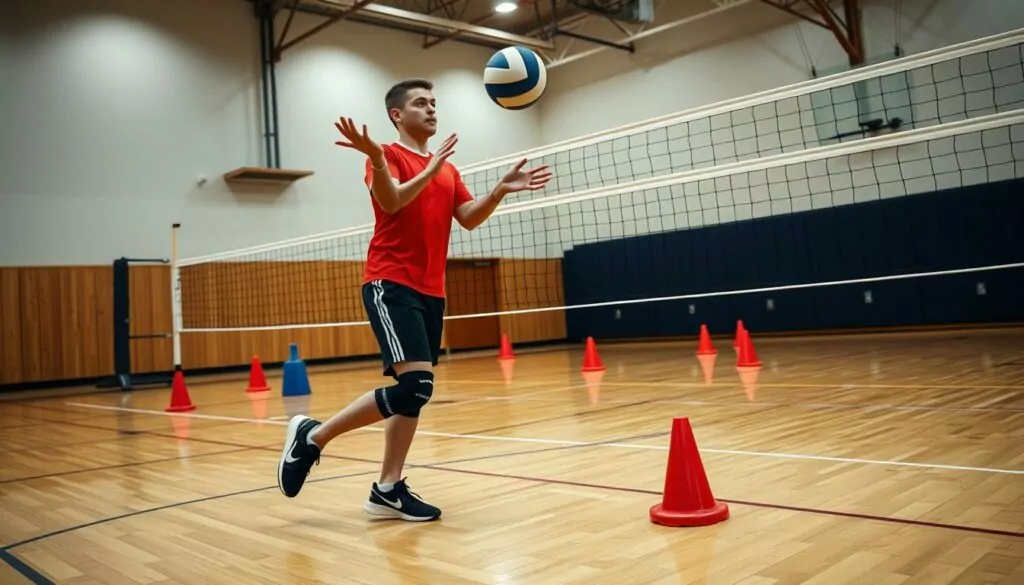
As a setter, mastering tempo is key to boosting your team’s offense. Quick and high sets are vital, needing precise timing and skill. Let’s explore drills to improve your game pace skills.
Quick Sets for Fast Attacks
Quick sets need fast reaction and teamwork with hitters. Practice drills for quick tempo to sharpen your skills. Try setting quick sets from different spots, aiming for perfect timing and accuracy.
High Sets for Powerful Hits
High sets let hitters show their power, but you need great control and strength. Try the “Harlem Globetrotters” drill for setting at various heights. It boosts your arm, wrist, and court awareness.
Practice regularly to get better at setting tempo. Embrace the challenge, and your volleyball setting techniques and setting practice will shine on the court.
Developing Visual Awareness as a Setter

Being a volleyball setter means you need strong visual awareness. Coach Greg Giovanazzi said the game is won or lost with vision and action. By improving your visual skills, you can become a better setter and help your team win.
Scanning the Court Effectively
Scanning the court well is key for setters. Look around before and during your sets. See where your hitters and opponents are.
This helps you decide where to place the ball. You can then meet your teammates’ needs and outsmart the defense.
Reading Opponents and Teammates
It’s also important to read your opponents and teammates. Watch their body language and movements. This tells you what they plan to do next.
Using visual cues in drills can boost your strategic play. Practice these skills to make quick, smart decisions. This leads to winning plays for your team.
Remember, visual awareness is key for top volleyball setters. Keep working on your scanning and reading. This will make you a better player and help your team win.
Drills to Enhance Setter Timing
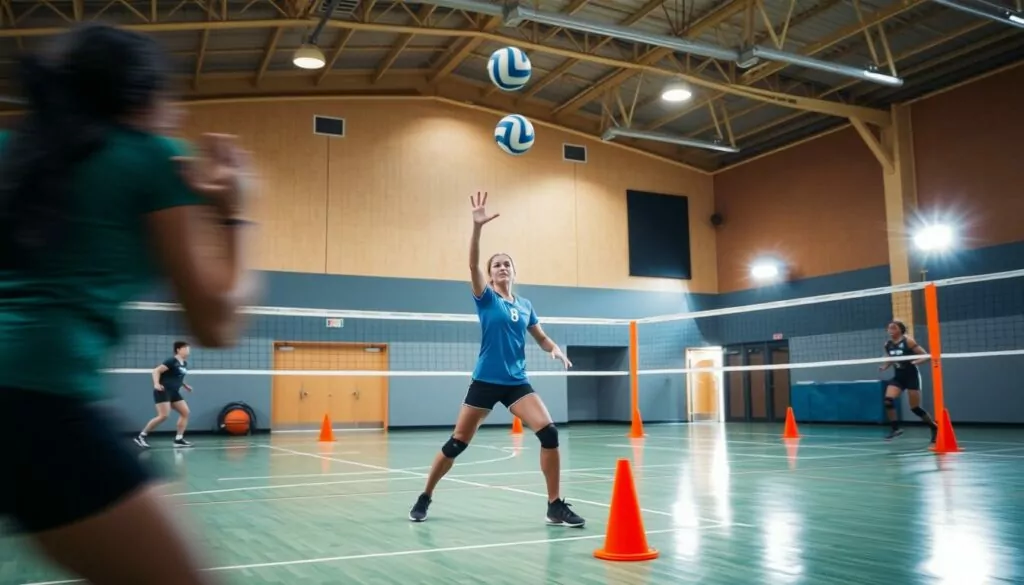
As a volleyball setter, timing is everything. It’s key to have a good setting rhythm and move in sync with your hitters. This ensures you deliver accurate, hittable sets. Let’s explore some important drills to improve your timing and boost your team’s offense.
Routines to Synchronize with Hitters
Creating consistent pre-set routines is vital for timing with hitters. Practice drills that focus on a smooth flow from catching the ball to setting it. The “Pass, Set, Set, Set, Catch” drill, loved by beach volleyball players, is perfect for this. It helps you get used to moving smoothly between passing, setting, and catching.
Understanding Ball Rhythm
Developing a good sense of ball rhythm is key for setters. The “Over the Net Pepper” drill tests your precision in setting, keeping a steady pace as the ball goes over the net. Watch the ball’s path and adjust your timing. This skill lets you set accurately, even when the game is fast.
The “Dig-Stay, Set-Leave, Hit-Leave” drill also helps. It teaches you to read the ball and stay in position to set well. Being able to adjust to the ball’s rhythm makes you a better setter.
Remember, regular practice and a focus on timing are essential. Add these drills to your routine. You’ll soon be in perfect sync with your hitters and leading the game.
Team Drills for Cohesive Setting
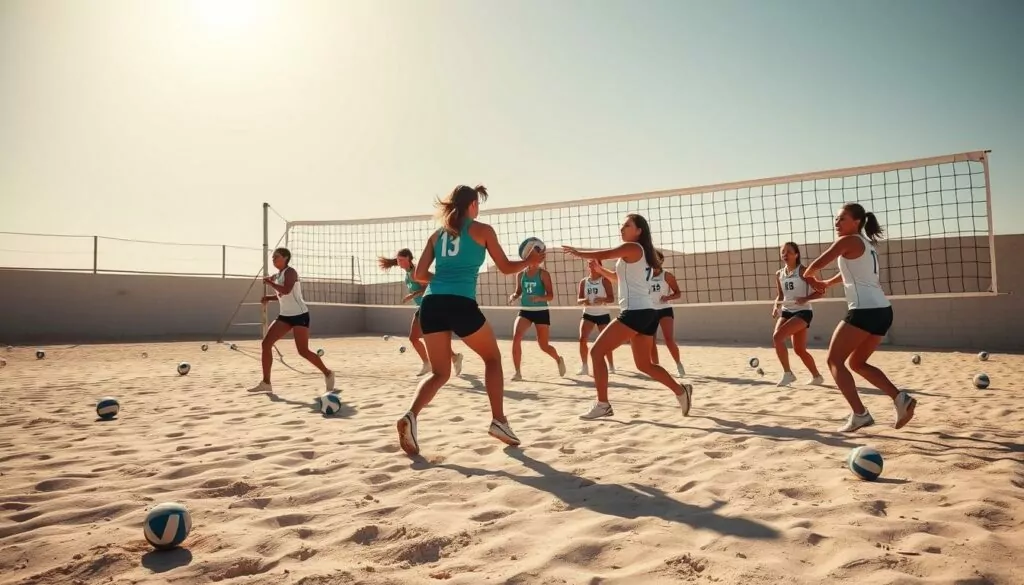
As a volleyball setter, working well with your hitters is key. Team drills help you do this. They also make you better at different plays. This way, you learn to work well together and make smart plays in games.
Incorporating Setters with Hitters
The “Circle Partner Setting” drill is great for team work. Setters and hitters stand in a circle and set to each other. It makes you better at adjusting your sets and improves teamwork.
Running Offensive Plays
Adding defensive players to drills makes you and your team better. Try out different plays like quick attacks and slide plays. This helps you make quick decisions and adjust your sets based on the defense.
Keep challenging yourself and your team with different drills. This focus on teamwork will help you lead your team to victory.
“The best setters are not the ones with the most physical talent, but the ones who can best communicate and connect with their teammates.”
The Importance of Feedback in Setting
As a volleyball setter, getting feedback is key to growing and improving. Asking for and listening to feedback from coaches and teammates can really boost your setting techniques and game performance.
How to Request and Receive Feedback
It’s okay to ask your coach or teammates for feedback on your setting. Be ready to hear their thoughts and try not to get defensive. Ask for specific, helpful feedback that you can use to get better. Remember, feedback is a chance to improve and become a better setter training.
Self-Assessment Techniques
- Watch video recordings of your setting to spot areas for improvement. Look at your hand positioning, footwork, and decision-making.
- Keep a journal to track your progress, note your strengths and weaknesses, and set goals for volleyball setting techniques.
- Ask your coach or a trusted mentor for their opinion on your setter development.
| Key Volleyball Setting Metrics | Importance |
|---|---|
| Percentage of Successful Attacks | Shows how well your setting leads to successful attacks. |
| Percentage of Errors Due to Poor Sets | Helps understand how your setting affects the team’s performance. |
| Average Sets per Setter | Shows your role and workload as the team’s setter. |
By actively seeking and using feedback, you can keep improving your setter training. This will make you a more dynamic and effective setter for your team.
“Giving feedback like: ‘That was an excellent pass because the elbows were locked and the arms were away from the body at a forty-five-degree angle’ provides efficient knowledge of performance and increased learning.”
Drills for Setting Consistency
Consistency is key for a great setter. As a volleyball player, I know how vital it is to hone my setting skills. These drills boost my accuracy and consistency. They also help me remember how to set well, even when it matters most.
Repetition vs. Quality in Drills
Finding the right mix of repetition and quality is key in setting drills. Doing lots of sets helps build muscle memory. But, it’s also vital to focus on setting each ball right. Bad habits can form if I don’t set correctly, so I always aim for the right form.
Building Muscle Memory
The “300 sets” drill is a favorite of mine for setting consistency. It’s simple: set the ball 300 times, focusing on hand position, footwork, and ball control. Doing this drill often has helped me set more accurately and consistently in games.
To keep improving, I mix up the distance and angle in my drills. This makes me better at setting from different spots on the court. It’s a great way to stay flexible and precise.
“Consistent setting is the foundation of a successful volleyball team. By mastering the fundamentals and drilling consistently, setters can elevate the entire offense and lead their team to victory.”
Getting better at setting takes time, effort, and a focus on details. By adding these drills to my routine, I’m sure I can set well. This will help my team do great on the court.
Using Technology to Improve Setting
I’m always looking to improve my volleyball setting skills. Technology has been a big help. I use video analysis and apps to see where I can get better and track my progress.
Video Analysis of Setting Techniques
Video sessions are key for me. I record my drills and games to check my hand position, footwork, and technique. This helps me spot what needs work and make changes to my form. It’s really helpful for improving my setter training and volleyball setting techniques.
Apps to Track Progress
I also use apps to track my setting. These apps show me how accurate my sets are, the ball’s speed, and where I’m placing the ball. This lets me see trends, check how drills affect me, and make better training choices. It’s all about using data to get better at setter training.
| App | Key Features | Benefits |
|---|---|---|
| Volleyball Setter Pro |
|
|
| Setter’s Toolkit |
|
|
Technology has really helped me improve my setter training and volleyball setting techniques. Using video and apps has been a big change for me. It’s helped me become a better setter.
Setting for Special Situations
As a volleyball setter, you face many game situations. This includes high-pressure moments and tough court positions. It’s key to learn quick setting techniques and adjust your approach during blocks.
Quick Sets in Crunch Time
In close matches, quick sets can be a game-changer. Practice drills like “Setting Under Pressure” to improve. This drill helps you make accurate sets when it matters most.
- Keep your hands and feet in the right position for quick, precise sets.
- Learn to read the court and guess what your hitters need in intense moments.
- Make quick sets a regular part of your practice to build confidence and skill.
Setting during a Block
When the other team blocks, you must adjust your setting. Practice setting from different angles and positions, even when off-balance or after a block.
- Set the ball high and away from the block to give your hitters more room to attack.
- Try setting the ball behind you or to the side to avoid the block and keep your hitters in a good spot.
- Work on setting quickly and decisively when the block is up, so your hitters have less time to swing.
Mastering quick sets and setting during blocks makes you a more valuable setter. You’ll help your team succeed in any situation.
Creating a Personal Practice Plan
As a volleyball player, making a personal practice plan is key to better setting skills. Focus on your strengths and weaknesses, set clear goals, and mix technical drills with game-like situations. This way, you can improve faster and become a better setter.
Setting Goals for Improved Performance
Begin by setting specific, measurable goals for your setting. These could be short-term, like getting better at setting consistency, or long-term, like improving your setting range. Use the SMART framework to make sure your goals are clear and achievable.
Balancing Skill Work with Game Situations
Your practice plan should mix technical drills with game-like scenarios. Spend time on setter training like hand positioning and footwork. Also, practice volleyball setting progressions in different game situations, like setting under pressure.
This balance will help you master both technical skills and game-specific abilities. Always check your progress and tweak your plan to keep improving.
“Consistent, focused practice is the key to becoming a great setter. Develop a plan that challenges you and keeps you engaged.”
Adding different drills to your plan will cover all setting aspects. Try everything from basic wall sets to advanced back-row setting. Each drill helps you grow as a setter.
The best practice plans are those made just for you. By tailoring your approach, you’ll become more confident and skilled on the court.
Conclusion: Becoming a Better Setter
Being a volleyball setter is a journey of learning and growing. It doesn’t matter if you’re new or have lots of experience. There’s always a chance to get better at setting. By practicing regularly, looking for more resources, and always wanting to learn, you can improve a lot.
Continuous Learning and Adaptation
The game of volleyball keeps changing with new moves and strategies. As a setter, you need to keep up with these changes. Go to volleyball camps and clinics to learn from experts. Always check how you’re doing and work on getting better.
Seeking Additional Resources and Training
Don’t just practice on your own. Look for more ways to improve your setting. Watch online tutorials and videos, and read books about volleyball. Talk to other setters to share tips and learn from them. By always looking to get better, you’ll become a top-notch setter.
